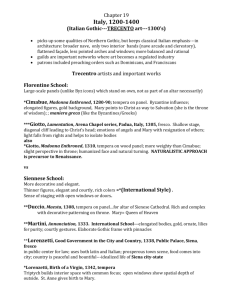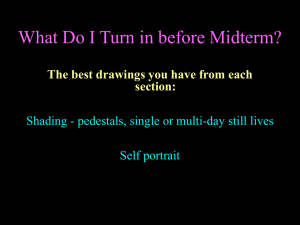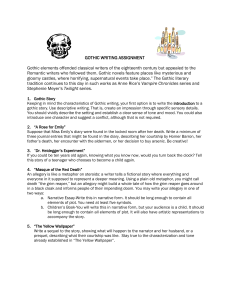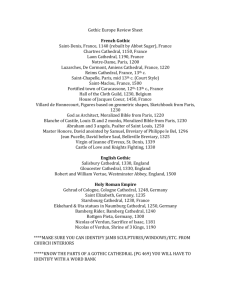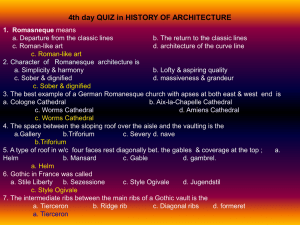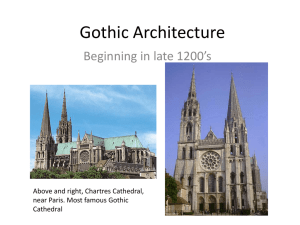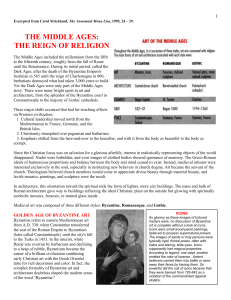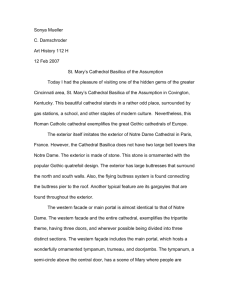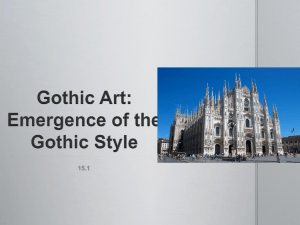Gothic Sculpture & Illustrated Books
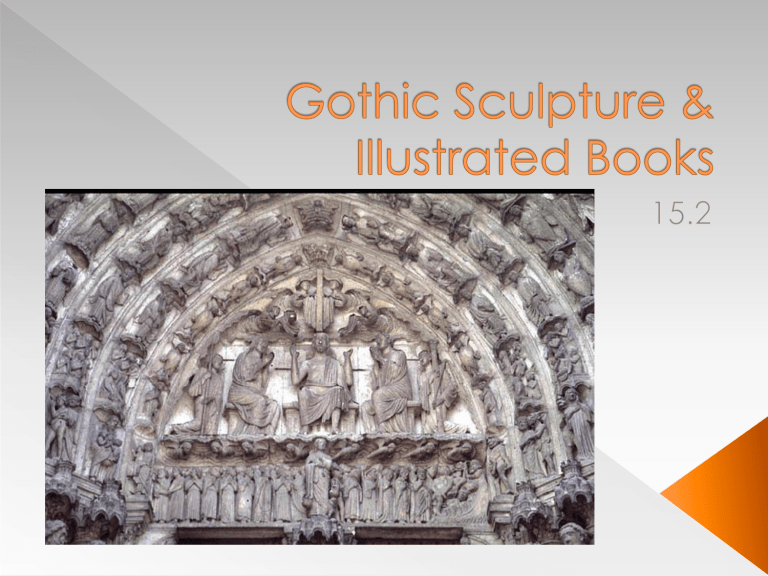
Gothic sculpture, like the stained glass of the period, was designed as part of one large composition-the cathedral erected to the glory of God.
Gradually, sculpture developed along more realistic and individualized lines, but it always complemented the architectural settings in which it was placed.
Seen from the narrow streets of
Medieval cities, the spires of
Gothic cathedrals stretched upward to heaven. This upward tendency is noted everywhere, in the pillars, pointed arches, and windows.
A statue of normal size and proportions attached to such a structure would have detracted from this soaring quality. To avoid this, sculptures, were elongated, or stretched out.
The repeated folds in their garments also emphasizes the vertical movement
Statues from the Royal
Portal of Chartres
Cathedral, France
Romanesque carvers made their figures appear firmly attached to the wall where as
Gothic sculptors made their project outward into space and each figure was clearly identifiable to anyone familiar with the Bible.
A figure holding keys was immediately identified as St.
Peter, who had been entrusted with the keys to the heavenly kingdom.
Another bearing stone tablets was recognized as Moses – the stone tablets being the 10 commandments.
Statues from the West
Portal at Terragona
Cathedral, Spain
Gothic sculptors wanted to do more than present sacred symbols of biblical figures. They wanted to make these figures look like real people.
The figures appear to move and look about and the drapery looks as though it covers a real 3-D body. Figures at Burgos Cathedral demonstrate this realism.
As the Gothic style developed further, an informal, more natural balance was sought.
Here 15 figures surround a bed on which rests the lifeless body of the Virgin Mary.
Figures are carefully designed to fit within the tympanum.
Christ is the largest figure, and if you look closely you will see that he holds a small version of Mary. This is her soul he is preparing to carry to heaven.
A sign for human emotion is noted in the sorrowful expressions.
They are real people expressing human emotions after the loss of a loved one.
Admiration for the Virgin Mary grew steadily during the
Gothic period. This was especially true in France, where great cathedrals were erected in her honor.
On the south portal of Amiens
Cathedral is an almost freestanding sculpture of
Mary holding the Christ Child.
Originally covered in gold, it came to be known as the
Golden Virgin. The figure is both elegant and noble. Its gentle human features and friendly expression made it one of the most famous sculptures in Europe
Golden Virgin. Right door called the
Mother of God. Amiens Cathedral. West façade. Amiens, France. C. 1250-70
One of the most interesting sculptural features of Gothic cathedrals was the inclusion of gargoyles, the grotesque flying monsters that project out from the upper portions of the huge churches.
Made of carved stone or cast metal, gargoyles are actually rain spouts, intended to carry rainwater from the roofs of the churches.
They are made to look evil spirits fleeing the sacred building for their lives. This was so that the spouts would be both functional and interesting.
A demand for illustrated books containing psalms, gospels, and other parts of the liturgy grew steadily during the
13 th and 14 th centuries.
These books called
“psalters” were the prized possessions of the wealthy.
Artists used tiny, pointed brushes and bright colors to illuminate these psalters with scenes from the life of
Christ.
During the 13 th and
14 th centuries, manuscript illumination showed the influence of stained-glass art.
These illustrations often were placed within a painted architectural framework that resembled the frames used for stained-glass windows.
The elegant figures found in these manuscript illuminations were drawn with firm, dark outlines, suggestive of the lead strips used to join sections of stained-glass.
Gothic Stained
Glass >
< Gothic
Illuminated
Manuscript
The influence of stained glass can be seen in an illumination in a 13 th century English book of prayers known as the
Carrow Psalter.
This full page illustration shows the assassination of Thomas A.
Becket, archbishop of
Canterbury, before the alter of his cathedral.
Four knights are seen attacking the kneeling archbishop with such fury that the blade of one sword breaks. An astonished church attendant looks on as the archbishop is forced to the floor by the swords and the foot of one knight.
In the years that followed, painters began to exhibit a greater concern for realistic detail in their works.
Even more important, was a desire to make their painted figures more graceful and colorful. They took delight in painting elegant and beautiful subjects with care and precision.
The elegant art style appealed to the tastes of the wealthy throughout western Europe, and the demand for manuscripts illustrated in this manner come to be known as international style.
Among the greatest artists working in the
International style were the Limbourg brothers.
Three brothers settled in France, where their patron was the Duke of Berry, the brother of the French king.
The brothers produced a luxurious book of prayers, or Book of Hours, for the duke.
Included in the book were a series of elaborate pictures illustrating the cycle of life through scenes from each of the 12 months.
In an illustration for the month of May, lords and ladies are shown enjoying a carefree ride in the warm sunshine.
The precision found in paintings of this kind is fascinating. The artists must have relished in the chance to demonstrate in paint their powers of observation.
The trees are painted with such exactness that each branch and many of the leaves stand out clearly.
The same detail is also seen in the castle.
To paint such detail, they must have painted with one hand while holding a magnifying glass with the other.
Desire for rich detail and gracefulness out weighs the need for realism which can bee seen in the treatment of the women sitting on the horses. Although not secure they look graceful and sophisticated.
Gargoyles
Growing Concern for Reality
Gothic Sculpture vs. Romanesque Sculpture
International Style
The Influence of Stained Glass


